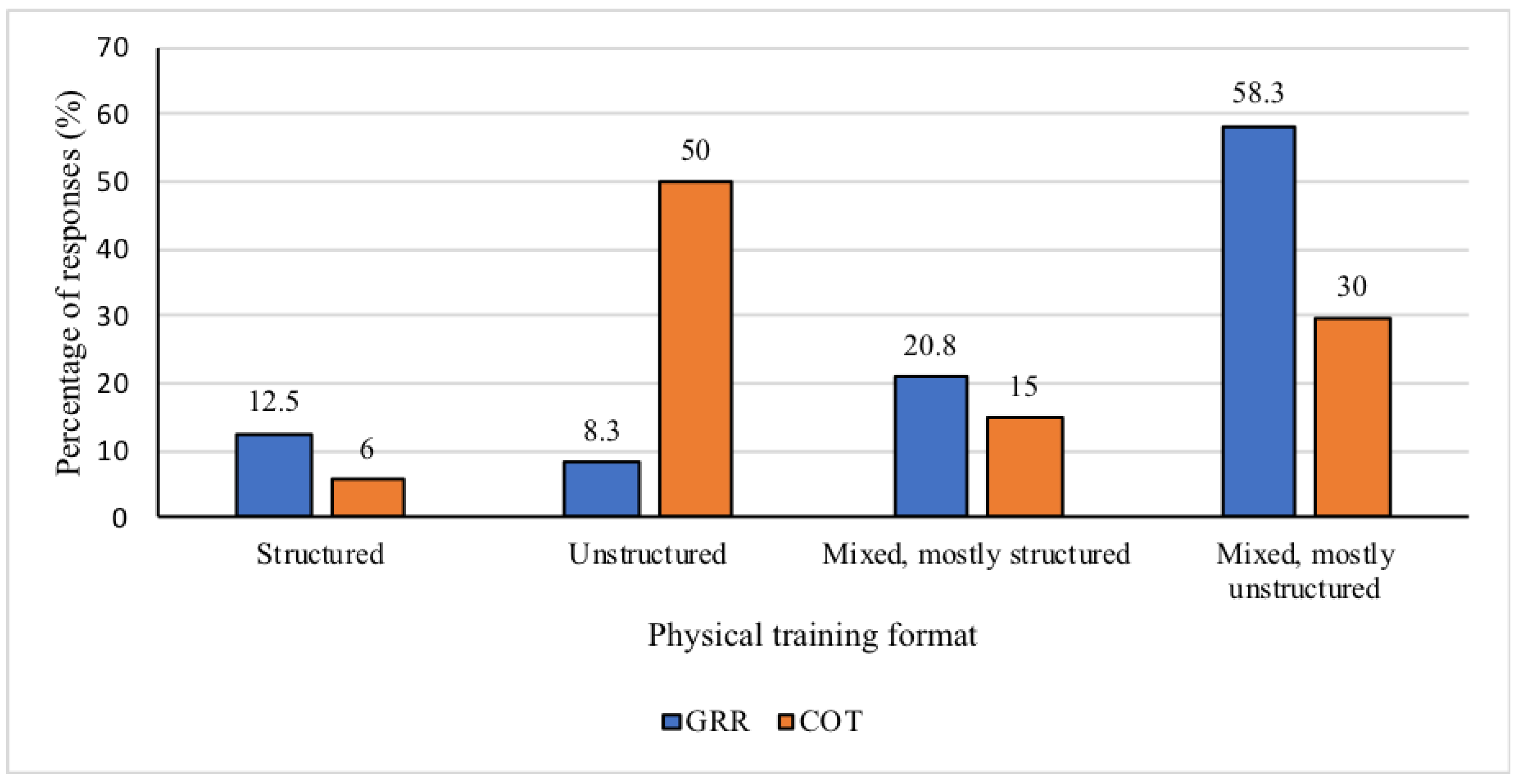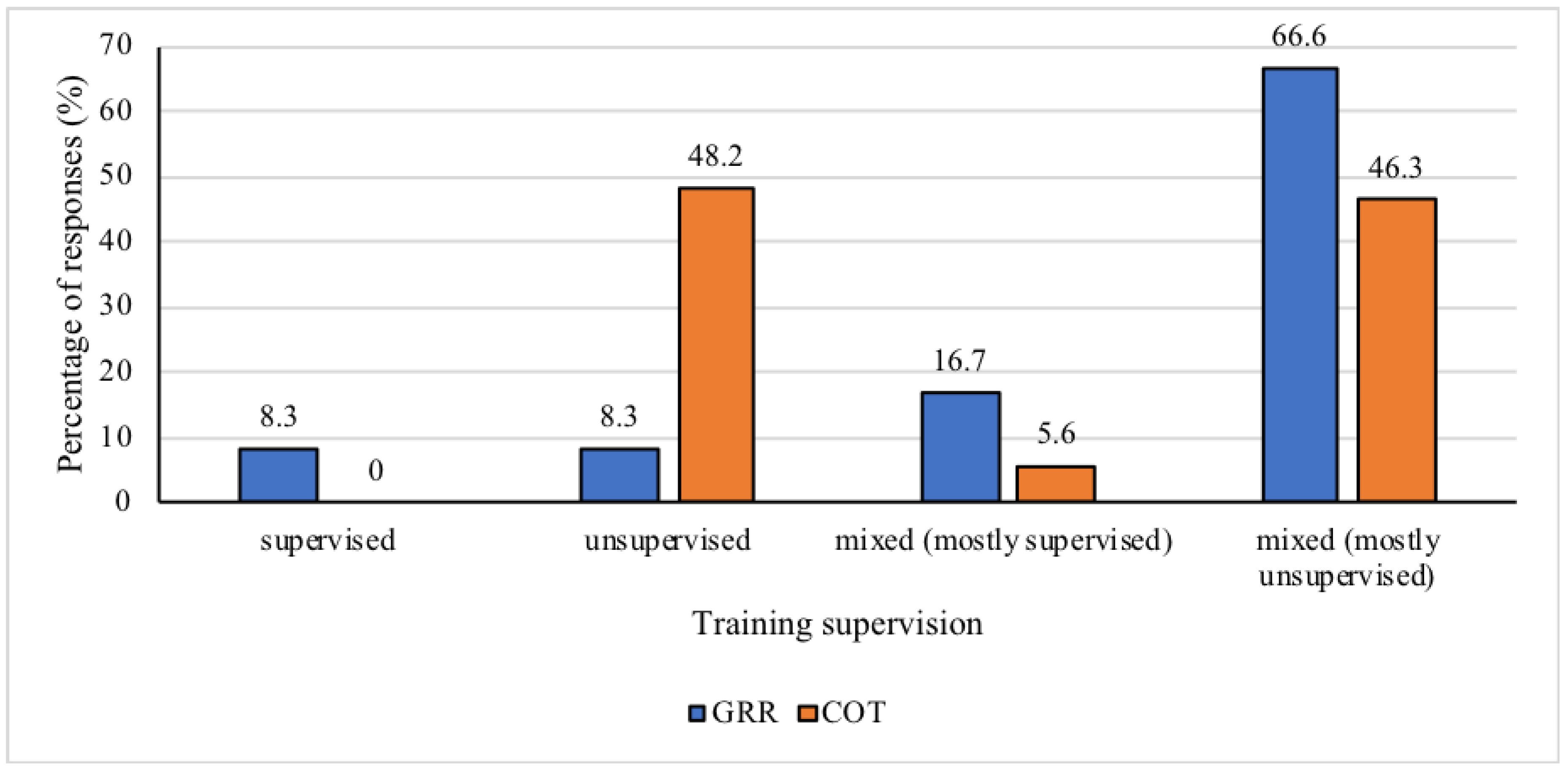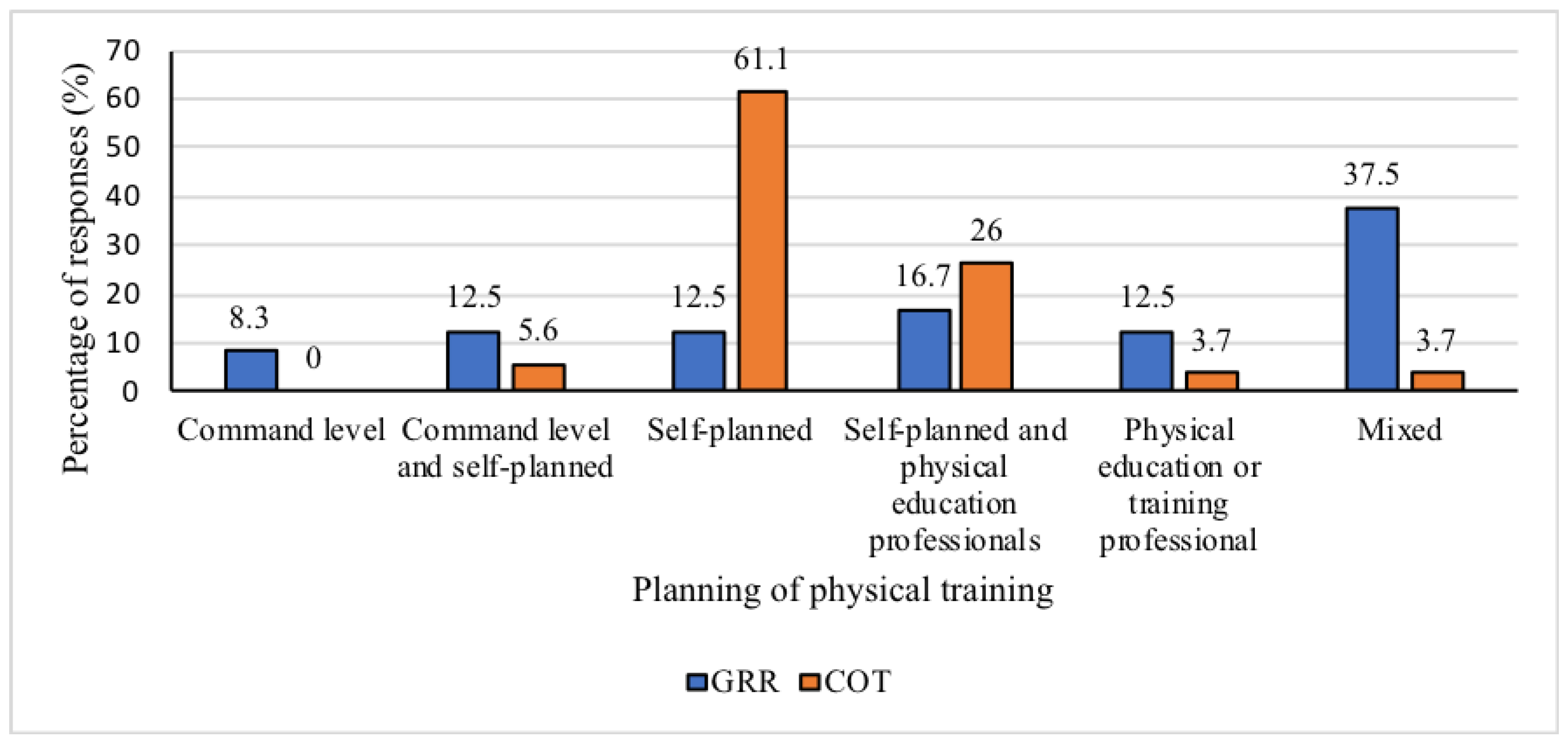Profile of Self-Reported Physical Tasks and Physical Training in Brazilian Special Operations Units: A Web-Based Cross-Sectional Study
Abstract
1. Introduction
2. Materials and Methods
2.1. Study Design
2.2. Settings
2.3. Participants
2.4. Procedures
2.5. Statistical Methods
3. Results
4. Discussion
Limitations
5. Conclusions
Author Contributions
Funding
Acknowledgments
Conflicts of Interest
References
- Fórum Brasileiro de Segurança Pública. Anuário Brasileiro de Segurança Pública; Fórum Brasileiro de Segurança Pública: Pinheiros, SP, Brazil, 2018; ISBN 1983-7634. [Google Scholar]
- Davis, M.R.; Easter, R.L.; Carlock, J.M.; Weiss, L.W.; Longo, E.A.; Smith, L.M.; Dawes, J.J.; Schilling, B.K. Self-Reported Physical Tasks and Exercise Training in Special Weapons and Tactics (SWAT) Teams. J. Strength Cond. Res. 2016, 30, 3242–3248. [Google Scholar] [CrossRef] [PubMed]
- Scofield, D.E.; Kardouni, J.R. The Tactical Athlete. Strength Cond. J. 2015, 37, 2–7. [Google Scholar] [CrossRef]
- Sefton, J.M.; Burkhardt, T.A. Introduction to the Tactical Athlete Special Issue. J. Athl. Train. 2016, 51, 845. [Google Scholar] [CrossRef] [PubMed]
- Silk, A.; Savage, R.; Larsen, B.; Aisbett, B. Identifying and characterising the physical demands for an Australian specialist policing unit. Appl. Ergon. 2018, 68, 197–203. [Google Scholar] [CrossRef]
- Zahabi, M.; Kaber, D. Identification of task demands and usability issues in police use of mobile computing terminals. Appl. Ergon. 2018, 66, 161–171. [Google Scholar] [CrossRef]
- Dawes, J.J.; Lindsay, K.; Bero, J.; Elder, C.; Kornhauser, C.; Holmes, R. Physical Fitness Characteristics of High vs. Low Performers on an Occupationally Specific Physical Agility Test for Patrol Officers. J. Strength Cond. Res. 2017, 31, 2808–2815. [Google Scholar] [CrossRef]
- Frio Marins, E.; Cabistany, L.; Bartel, C.; Dawes, J.J.; Boscolo Del Vecchio, F. Aerobic fitness, upper-body strength and agility predict performance on an occupational physical ability test among police officers while wearing personal protective equipment. J. Sports Med. Phys. Fitness 2019, 59. [Google Scholar] [CrossRef]
- Dulla, J.; Baran, K.; Pope, R.; Orr, R. Duty loads carried by the LA sheriff’s department officers. J. Sci. Med. Sport 2017, 20, S5–S6. [Google Scholar] [CrossRef]
- Marins, E.F.; Cabistany, L.; Farias, C.; Dawes, J.; Del Vecchio, F.B. Effects of Personal Protective Equipment on Metabolism and Performance during an Occupational Physical Ability Test for Federal Highway Police Officers. J. Strength Cond. Res. 2020, 34, 1093–1102. [Google Scholar] [CrossRef]
- Dempsey, P.C.; Handcock, P.J.; Rehrer, N.J. Impact of police body armour and equipment on mobility. Appl. Ergon. 2013, 44, 957–961. [Google Scholar] [CrossRef]
- Irving, S.; Orr, R.; Pope, R. Profiling the Occupational Tasks and Physical Conditioning of Specialist Police. Int. J. Exerc. Sci. 2019, 12, 173–186. [Google Scholar] [PubMed]
- Pryor, R.R.; Colburn, D.; Crill, M.T.; Hostler, D.P.; Suyama, J. Fitness Characteristics of a Suburban Special Weapons and Tactics Team. J. Strength Cond. Res. 2012, 26, 752–757. [Google Scholar] [CrossRef]
- Robinson, J.; Roberts, A.; Irving, S.; Orr, R. Aerobic Fitness Is of Greater Importance than Strength and Power in the Load Carriage Performance of Specialist Police. Int. J. Exerc. Sci. 2018, 11, 987–998. [Google Scholar] [PubMed]
- Maupin, D.; Wills, T.; Orr, R.; Schram, B. Fitness Profiles in Elite Tactical Units: A Critical Review. Int. J. Exerc. Sci. 2018, 11, 1041–1062. [Google Scholar]
- Marins, E.F.; David, G.B.; Del Vecchio, F.B. Characterization of the Physical Fitness of Police Officers. J. Strength Cond. Res. 2019, 33, 2860–2874. [Google Scholar] [CrossRef] [PubMed]
- Decker, A.; Orr, R.M.; Pope, R.; Hinton, B. Physiological demands of law enforcement occupational tasks in Australian police officers. In Proceedings of the ASCA National Conference on Applied Strength and Conditioning, Melbourne, Australia, 4–6 November 2016. [Google Scholar]
- Dawes, J.J.; Elder, C.; Hough, L.; Melrose, D.R.; Stierli, M. Description of selected physical performance measures and anthropometric characteristics of part and full time special weapons and tactics teams. J. Aust. Strength Cond. 2013, 21, 52. [Google Scholar]
- Myers, C.J.; Orr, R.M.; Goad, K.S.; Schram, B.L.; Lockie, R.; Kornhauser, C.; Holmes, R.; Dawes, J.J. Comparing levels of fitness of police Officers between two United States law enforcement agencies. Work 2019, 63, 615–622. [Google Scholar] [CrossRef]
- Vandenbroucke, J.P.; von Elm, E.; Altman, D.G.; Gøtzsche, P.C.; Mulrow, C.D.; Pocock, S.J.; Poole, C.; Schlesselman, J.J.; Egger, M.; Blettner, M.; et al. Strengthening the Reporting of Observational Studies in Epidemiology (STROBE): Explanation and elaboration. Int. J. Surg. 2014, 12, 1500–1524. [Google Scholar] [CrossRef]
- Maupin, D.; Robinson, J.; Wills, T.; Irving, S.; Schram, B.; Orr, R. Profiling the metabolic fitness of a special operations police unit. J. Occup. Health 2018, 60, 356–360. [Google Scholar] [CrossRef]
- Orr, R.M.; Robinson, J.; Hasanki, K.; Talaber, K.A.; Schram, B.; Roberts, A. The Relationship between Strength Measures and Task Performance in Specialist Tactical Police. J. Strength Cond. Res. 2020. [Google Scholar] [CrossRef]
- Orr, R.M.; Dawes, J.J.; Lockie, R.G.; Godeassi, D.P. The Relationship between Lower-Body Strength and Power, and Load Carriage Tasks: A Critical Review. Int. J. Exerc. Sci. 2019, 12, 1001–1022. [Google Scholar] [PubMed]
- Thomas, R.; Schram, B.; Irving, S.; Robinson, J.; Orr, R. Associations between specialist tactical response police unit selection success and urban rush, along with 2.4 km and 10 km loaded carriage events. Int. J. Environ. Res. Public Health 2019, 16, 3558. [Google Scholar] [CrossRef] [PubMed]
- Anderson, G.; Plecas, D.; Segger, T. Police officer physical ability testing–Re-validating a selection criterion. Polic. Int. J. Police Strateg. Manag. 2001, 24, 8–31. [Google Scholar] [CrossRef]
- Arvey, R.D.; Landon, T.E.; Nutting, S.M.; Maxwell, S.E. Development of physical ability tests for police officers: A construct validation approach. J. Appl. Psychol. 1992, 77, 996–1009. [Google Scholar] [CrossRef] [PubMed]



| Characteristic | GRR (n = 24) | COT (n = 54) | ||
|---|---|---|---|---|
| Mean ± SD | Range (min–max) | Mean ± SD | Range (min–max) | |
| Age (years) | 33.6 ± 3.5 | 27–41 | 35.5 ± 5.5 | 27–55 |
| Height (cm) | 175 ± 6.4 | 166–193 | 179.7 ± 6.1 | 168–193 |
| Body mass (kg) | 81.2 ± 8.0 | 69–100 | 84.7 ± 7.0 | 70–99 |
| Police activity time (years) | 6.3 ± 4.1 | 3–20 | 8.5 ± 4.7 | 3–23 |
| Time as member of a SOPU (years) | 2.8 ± 0.4 | 2–3 | 5.2 ± 4.8 | 1–20 |
| Method | Responses | Estimated Mean % BF ± SD |
|---|---|---|
| Skinfold calipers | 7 | 13.0 ± 1.7 |
| Circumferences | 2 | 16.0 ± 1.4 |
| DEXA | 1 | 16.0 ± 0 |
| Bioelectrical impedance | 27 | 13.0 ± 4.1 |
| Task | GRR (n = 24) | COT (n = 54) | ||||||
|---|---|---|---|---|---|---|---|---|
| Frequency | Importance | Difficulty | Mean | Frequency | Importance | Difficulty | Mean | |
| Standing and/or sitting with all equipment for extended periods | 2.3 ± 2.1 | 2.0 ± 1.8 | 4.6 ± 1.8 | 3.5 ± 1.4 | 2.1 ± 1.7 | 1.9 ± 1.5 | 4.4 ± 1.5 | 3.3 ± 1.1 |
| Break a door | 3.2 ± 1.4 | 2.1 ± 1.4 | 4.7 ± 1.8 | 3.9 ± 1.2 | 2.2 ± 1.7 | 1.6 ± 1.4 | 5.2 ± 1.6 | 3.7 ± 1.0 |
| Walk fast or run continuously for more than 10 min | 3.3 ± 1.7 | 1.9 ± 1.5 | 4.5 ± 1.7 | 3.9 ± 1.4 | 3.2 ± 1.8 | 2.8 ± 1.8 | 5.0 ± 1.8 | 4.1 ± 1.1 |
| Run fast for less than 30 s | 3.4 ± 2.1 | 2.0 ± 1.5 | 4.5 ± 2.1 | 4.0 ± 1.6 | 2.7 ± 1.5 | 2.2 ± 1.5 | 5.3 ± 1.8 | 4.0 ± 1.1 |
| Fight/immobilize/handcuff someone who resists being arrested | 4.8 ± 1.6 | 2.6 ± 1.8 | 3.3 ± 1.6 | 4.0 ± 1.1 | 3.6 ± 1.5 | 2.0 ± 1.6 | 4.4 ± 1.6 | 4.0 ± 1.0 |
| Maintaining a tactical position for a long period (>15 min) | 3.6 ± 2.0 | 2.8 ± 2.0 | 4.0 ± 1.6 | 3.8 ± 1.3 | 3.2 ± 1.9 | 2.3 ± 1.6 | 4.5 ± 1.6 | 3.9 ± 1.1 |
| Lift/push/pull objects of average weight (approximately 20 to 70 kg) | 4.1 ± 1.9 | 3 ± 1.8 | 3.4 ± 1.4 | 3.8 ± 1.1 | 2.9 ± 1.5 | 2.6 ± 1.6 | 4.7 ± 1.5 | 3.8 ± 1.0 |
| Walking long distances (>1 h) | 3.8 ± 1.8 | 2.6 ± 1.7 | 4.5 ± 1.7 | 4.1 ± 1.2 | 3.7 ± 1.3 | 2.8 ± 1.7 | 4.7 ± 1.6 | 4.2 ± 1.0 |
| Work in small spaces/tunnels/openings/wells and hiding places | 3.8 ± 1.7 | 3.3 ± 1.9 | 3.8 ± 1.5 | 3.8 ± 1.2 | 4.0 ± 1.8 | 3.3 ± 1.7 | 4.1 ± 1.5 | 4.1 ± 1.0 |
| Lift/push/pull heavier objects (heavier than an adult man) | 4.6 ± 1.8 | 3.5 ± 2.1 | 2.9 ± 1.7 | 3.8 ± 1.2 | 4.1 ± 1.3 | 3.6 ± 1.6 | 2.8 ± 1.5 | 3.5 ± 1.0 |
| Fire a rifle | 3.7 ± 1.7 | 1.8 ± 1.6 | 5.6 ± 2.0 | 4.6 ± 1.4 | 3.2 ± 1.8 | 1.9 ± 1.8 | 5.7 ± 1.7 | 4.5 ± 1.2 |
| Climb/jump/cross an obstacle (such as a wall or fence) higher than you | 4.1 ± 1.7 | 3.1 ± 1.9 | 3.8 ± 1.5 | 3.9 ± 1.2 | 3.6 ± 1.4 | 3.2 ± 1.7 | 4.4 ± 1.7 | 4.0 ± 1.1 |
| Maintain balance to avoid falling or dodging obstacles and objects | 3.7 ± 2.0 | 2.8 ± 1.9 | 4.9 ± 1.7 | 4.3 ± 1.2 | 2.8 ± 1.6 | 2.4 ± 1.6 | 5.3 ± 1.6 | 4.0 ± 1.1 |
| Hanging only by the force of the arms | 5.1 ± 1.6 | 3.9 ± 2.3 | 4 ± 2.1 | 3.8 ± 1.4 | 4.7 ± 1.5 | 3.9 ± 1.8 | 3.9 ± 1.7 | 3.6 ± 1.3 |
| Jump/cross an obstacle (such as a wall or fence) lower than your waist height | 3.7 ± 1.6 | 2.6 ± 1.7 | 5.4 ± 1.9 | 4.5 ± 1.2 | 2.8 ± 1.4 | 2.4 ± 1.6 | 5.7 ± 1.6 | 4.3 ± 1.0 |
| Equip/unequip quickly | 3.6 ± 1.8 | 3.2 ± 2.1 | 4.8 ± 2.0 | 4.2 ± 1.3 | 3.2 ± 1.8 | 2.5 ± 1.7 | 5.1 ± 1.5 | 4.2 ± 1.1 |
| Float/traverse watercourse | 5.1 ± 2.0 | 3.7 ± 2.3 | 3.4 ± 2.1 | 4.3 ± 1.2 | 4.5 ± 1.8 | 3.5 ± 2.0 | 4.9 ± 1.6 | 4.7 ± 1.1 |
| Crawl | 5.1 ± 2.0 | 4.5 ± 2.1 | 4.3 ± 1.7 | 4.7 ± 1.3 | 5.1 ± 1.5 | 4.2 ± 1.9 | 4.1 ± 1.9 | 4.6 ± 1.1 |
| Use abseiling techniques at heights above 3 m | 5.3 ± 2.2 | 4.5 ± 1.8 | 3.8 ± 1.8 | 4.6 ± 1.3 | 5.4 ± 1.5 | 4.6 ± 1.7 | 4.8 ± 1.7 | 5.1 ± 1.2 |
| Hanging up using arms and legs (laziness position) | 5.4 ± 1.7 | 4.4 ± 2.3 | 4.3 ± 2.0 | 4.8 ± 1.4 | 5.1 ± 1.4 | 4.2 ± 1.9 | 4.1 ± 1.8 | 4.6 ± 1.1 |
| Training Goal | GRR (n = 24) | COT (n = 54) |
|---|---|---|
| Rating (Mean ± SD) | Rating (Mean ± SD) | |
| Aerobic endurance | 2.0 ± 1.7 | 2.9 ± 1.8 |
| Muscle power | 3.6 ± 2.0 | 3.4 ± 1.9 |
| Muscle strength | 3.4 ± 1.8 | 2.1 ± 1.6 |
| Muscle endurance | 3.3 ± 1.7 | 3.6 ± 1.5 |
| Agility | 4.8 ± 1.4 | 5.1 ± 1.5 |
| Balance | 6.6 ± 1.3 | 6.5 ± 1.3 |
| Coordination | 6.5 ± 1.8 | 6.5 ± 1.5 |
| Flexibility | 5.9 ± 1.6 | 6.1 ± 1.8 |
© 2020 by the authors. Licensee MDPI, Basel, Switzerland. This article is an open access article distributed under the terms and conditions of the Creative Commons Attribution (CC BY) license (http://creativecommons.org/licenses/by/4.0/).
Share and Cite
Marins, E.; Barbosa, O.; Machado, E.; Orr, R.; Dawes, J.; Del Vecchio, F. Profile of Self-Reported Physical Tasks and Physical Training in Brazilian Special Operations Units: A Web-Based Cross-Sectional Study. Int. J. Environ. Res. Public Health 2020, 17, 7135. https://doi.org/10.3390/ijerph17197135
Marins E, Barbosa O, Machado E, Orr R, Dawes J, Del Vecchio F. Profile of Self-Reported Physical Tasks and Physical Training in Brazilian Special Operations Units: A Web-Based Cross-Sectional Study. International Journal of Environmental Research and Public Health. 2020; 17(19):7135. https://doi.org/10.3390/ijerph17197135
Chicago/Turabian StyleMarins, Eduardo, Ossian Barbosa, Eduardo Machado, Robin Orr, Jay Dawes, and Fabrício Del Vecchio. 2020. "Profile of Self-Reported Physical Tasks and Physical Training in Brazilian Special Operations Units: A Web-Based Cross-Sectional Study" International Journal of Environmental Research and Public Health 17, no. 19: 7135. https://doi.org/10.3390/ijerph17197135
APA StyleMarins, E., Barbosa, O., Machado, E., Orr, R., Dawes, J., & Del Vecchio, F. (2020). Profile of Self-Reported Physical Tasks and Physical Training in Brazilian Special Operations Units: A Web-Based Cross-Sectional Study. International Journal of Environmental Research and Public Health, 17(19), 7135. https://doi.org/10.3390/ijerph17197135








